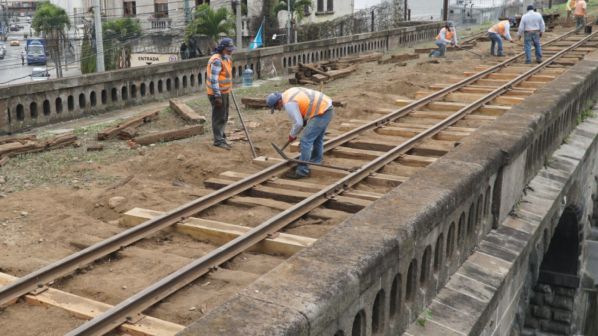ORGINALLY due to start on January 20, work to revive Guatemala’s currently disused 914mm-gauge network as a modern 1435mm-gauge freight railway and build new cross-border links to El Salvador and Honduras has been set back by political circumstances and related administrative delays, according to Remed Mexico operating manager, Mr Mauricio De León.
Following the election of Mr Bernardo Arévalo as Guatemala’s next president in August, the handover of power and the transition to a new government has proved to be a lengthy and at times controversial process. Arévalo is now expected to take up office next month, and De León hopes that work can begin in earnest later in 2024 once the new administration has finished “dotting the Is and crossing the Ts” of the remaining paperwork and complete the other tasks that it is responsible for, such as clearing illegal construction that has encroached on the right of way since the last trains ran in September 2007.
Comprising 800km of new or upgraded railway and expected to take two years to complete at a total cost of $US 1.76bn, the Remed project has been divided into three stages.
Stage 1 mainly comprises an upgrade of the 235km running from Tecún Umán on the Mexican border via Río Bravo and Santa María (north of Obrero) to Puerto Quetzal, Guatemala’s largest port on the Pacific coast. The focus of Stage 2 is to revive rail links to Caribbean ports, involving the upgrade of 317km running inland from Puerto Barrios and Santo Tomás de Castilla, just south of Puerto Barrios, to Zacapa and Guatemala City. Stage 2 includes upgrading the 89km route from Guatemala City to Santa María, connecting stages 1 and 2. Under Stage 3, a 91km line will be built to the border with El Salvador from Obrero, on Stage 1. The new 19km line to the Honduras border runs from Entre Ríos near Santo Tomás on Stage 2.
Pending the start of this major construction programme, work is now underway in Guatemala to lay track at the freight terminal, free port and industrial park that Remed is developing in Tecún Umán with a view to start moving freight by rail to Mexico, the United States and Canada as soon as possible. As De León explains, this has seen Remed acquire an adjacent site from fertiliser company Duwest. Combined with dedicated customs facilities at Tecún Umán and electronic document transfer, Remed believes that these new rail-connected facilities have the potential to substantially reduce the time it takes for freight to cross the border from Guatemala into Mexico.
“We don’t need an operator for a while, when we start building, I think we’ll have a queue for that.”
Mr Mauricio De León, Remed Mexico operating manager
With the current road crossing congested with large numbers of small lorries, De León says that it can take “hours and hours” to complete border formalities, which include the requirement for road vehicles to change number plates from one country to another. Combined with the poor state of the road network, this means that freight moving by lorry from Guatemala to Mexico and the US can take between seven and 14 days to reach its destination.
The value of Guatemala’s exports was an estimated $US 15.3bn in 2021, of which 32% went to the United States, 12% to El Salvador, 10% to Honduras and 4% to Mexico. Faster rail service would therefore have significant benefits for Guatemalan companies exporting agricultural products such as bananas, raw sugar and palm oil, of which a great deal is destined for the US, according to De León. “A massive amount rots in transit,” he says. “The freight infrastructure isn’t there and their output is constrained by their ability to move it.”
Passenger prospects
Cross-border shopping trips are popular in Guatemala, De León notes, due to both the relative strength of the quetzal against the Mexican peso and the wider range of goods available in Mexico. “A passenger service would make a lot of sense for tourism,” he says.
Although the focus of Remed’s project is very much on freight, development work has included examining the potential for operating passenger services to serve the 3.1 million inhabitants of Guatemala City using battery-powered rolling stock developed by British rolling stock supplier Vivarail, which entered administration in December 2022. Deploying Vivarail’s quick-charging technology would have offered the potential to decarbonise local transport in Guatemala, taking advantage of comparatively cheap hydro-electric power and avoiding the need to install overhead electrification equipment where clearances might be limited.
Remed is still working to determine which of the 200 stations on the national network it will require, and De León reports that discussions are also continuing with potential passenger operators. No final decisions have yet been made on what contractual shape this would take, however. “We are open to any possibility,” he says.
Similarly, for the core freight operations on Guatemala’s revived national network this issue is “not settled yet”, but as De León points out “Remed has no operating experience” and will probably require a suitably qualified partner. Discussions have been held with a number of potential operators, but “we don’t need an operator for a while,” he says. “When we start building, I think we’ll have a queue for that.”

